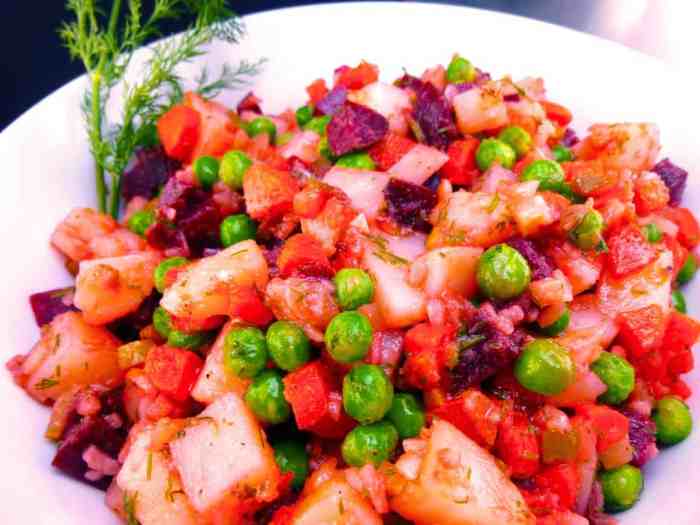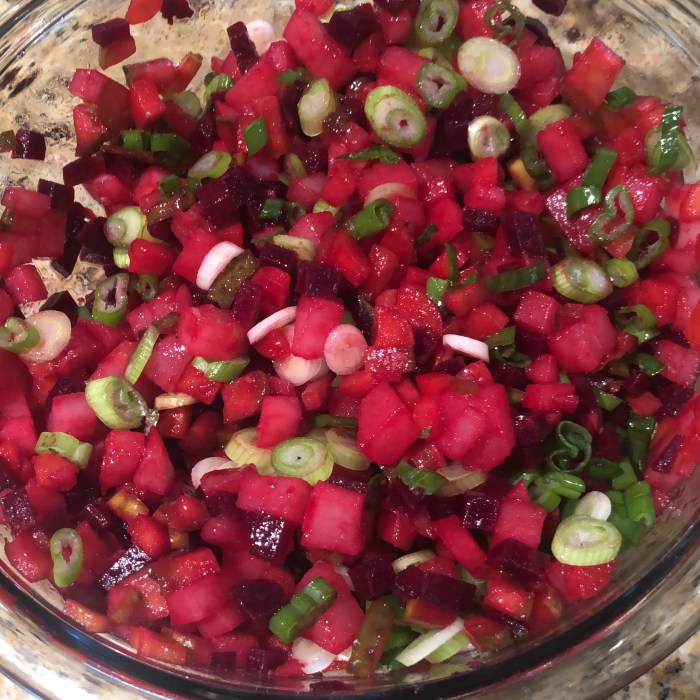
Russian Beet and Potato Salad: A Flavorful Journey
Russian beet and potato salad, a vibrant dish bursting with color and flavor, takes us on a culinary journey through Eastern Europe. This salad, a staple in many Russian and Slavic households, is more than just a side dish; it’s a celebration of tradition, a testament to the ingenuity of home cooks, and a delicious representation of cultural heritage.
The origins of this salad are steeped in history, with its roots dating back to the 19th century. Over time, it has evolved, taking on regional variations and unique twists, while still maintaining its core essence of simplicity and deliciousness.
From the earthy sweetness of the beets to the creamy richness of the potatoes, every ingredient plays a vital role in creating a harmonious symphony of flavors.
History and Origins

The Russian beet and potato salad, known as “vinaigrette” in Russian, is a beloved classic that has been enjoyed for centuries. Its origins can be traced back to the 19th century, during a time when both beets and potatoes were readily available and affordable ingredients in Russia.The salad’s evolution is closely tied to the culinary traditions of the country, influenced by various factors such as seasonal availability of ingredients, regional preferences, and cultural exchanges.
Cultural Significance
Vinaigrette holds a special place in Russian cuisine, reflecting the country’s culinary heritage and agricultural bounty. It is a staple dish served at both everyday meals and special occasions, such as family gatherings, holidays, and celebrations. The salad’s popularity extends beyond Russia, as it is also enjoyed in other Slavic countries, including Ukraine, Belarus, and Poland, where it is often prepared with slight variations in ingredients and flavors.
Traditional Ingredients and Preparation Methods
The traditional vinaigrette recipe features a simple yet flavorful combination of ingredients, including:
- Beets:Cooked and diced, beets provide the salad’s signature vibrant red color and earthy sweetness.
- Potatoes:Boiled and diced, potatoes add a creamy texture and starchy base to the salad.
- Pickled cucumbers:The tangy and crunchy pickled cucumbers offer a refreshing contrast to the sweetness of the beets and potatoes.
- Onions:Finely chopped onions add a pungent flavor and aromatic complexity to the salad.
- Sour cream or mayonnaise:Used as a dressing, sour cream or mayonnaise adds richness and creaminess to the salad.
- Salt and pepper:To taste, salt and pepper enhance the flavors of the ingredients.
The preparation method is relatively straightforward:
The beets, potatoes, and cucumbers are boiled until tender and then diced into small pieces. The onions are finely chopped. All ingredients are then combined in a bowl and mixed with the dressing.
Vinaigrette is typically served chilled, allowing the flavors to meld and the salad to develop a satisfyingly creamy texture.
Variations and Regional Differences
While the basic ingredients of Russian beet and potato salad remain consistent, regional variations exist, reflecting local culinary traditions and preferences. These variations often involve the addition of unique ingredients, different cooking methods, and distinctive flavor profiles.
Regional Variations of Russian Beet and Potato Salad
The diverse regions of Russia offer a fascinating tapestry of culinary traditions, each with its own interpretation of this beloved salad. Here are some notable regional variations:
- Moscow:In the capital city, the salad often includes a generous amount of mayonnaise, giving it a rich and creamy texture. It may also feature a sprinkle of chopped dill for a touch of freshness.
- St. Petersburg:St. Petersburg’s version of the salad often incorporates a combination of sour cream and mayonnaise, resulting in a tangier and lighter flavor. It may also include finely chopped onions for added bite.
- Siberia:In the vast Siberian region, the salad is often made with a blend of mayonnaise and mustard, adding a spicy kick. It may also feature chopped walnuts for a nutty flavor and texture.
- Caucasus:The Caucasus region is known for its use of fresh herbs and spices. The salad here may include chopped cilantro, parsley, and a generous amount of garlic, creating a vibrant and aromatic flavor profile.
Preparation Methods and Ingredients
Regional variations in Russian beet and potato salad extend beyond the ingredients to encompass different preparation methods.
- Boiling:In some regions, the beets and potatoes are boiled until tender, then peeled and diced. This method ensures a smooth and consistent texture.
- Roasting:In other regions, the beets and potatoes are roasted in the oven, resulting in a sweeter and more caramelized flavor. This method also adds a touch of complexity to the salad.
- Pickling:Some variations incorporate pickled beets, which add a tangy and slightly sour flavor. Pickled beets are often used in regions with a colder climate, where preserving food is essential.
Notable Variations of Russian Beet and Potato Salad
- Vinegret:A popular variation, vinegret, features a combination of beets, potatoes, carrots, pickled cucumbers, and onions, all marinated in a vinaigrette dressing. It is a flavorful and refreshing salad, often served as a side dish or a light meal.
- Shuba:This layered salad features a base of boiled potatoes, followed by layers of beets, carrots, herring, and mayonnaise. It is a festive and visually appealing dish, often served on special occasions.
Ingredients and Flavor Profile: Russian Beet And Potato Salad
The symphony of flavors in Russian beet and potato salad arises from a carefully curated blend of ingredients, each playing a vital role in creating a harmonious taste experience. This salad is a testament to the art of balancing sweet, sour, and savory notes, resulting in a dish that is both refreshing and satisfying.
Key Ingredients and Their Roles
The foundation of this salad is built upon two humble yet versatile ingredients: beets and potatoes. Beets, with their vibrant crimson hue and earthy sweetness, contribute a rich, almost syrupy flavor. Potatoes, on the other hand, provide a creamy texture and a mild, slightly starchy taste.
Russian beet and potato salad is a classic dish that always reminds me of family gatherings. The vibrant colors and tangy flavors are a welcome contrast to the hearty, comforting dishes that often accompany it. Speaking of comforting, another dish that always hits the spot is a spaetzle sauerkraut and sausage casserole.
The combination of creamy spaetzle, tangy sauerkraut, and savory sausage is simply irresistible. And just like the Russian beet and potato salad, it’s a dish that brings people together.
These two components form the base, upon which other ingredients layer complexity and depth.
- Beets:The beets are typically cooked until tender, then peeled and diced or grated. Their sweetness is often enhanced by the addition of sugar or honey, while their natural acidity is further accentuated by the use of vinegar.
- Potatoes:Potatoes are boiled until fork-tender, then peeled and diced or mashed. Their starchy nature contributes to the salad’s creamy texture, while their subtle flavor allows the other ingredients to shine.
- Onions:Onions, whether red, white, or yellow, add a pungent, savory note to the salad. They can be finely chopped, sliced, or even pickled for an extra layer of complexity.
- Pickles:Pickles, typically dill or gherkin, provide a tangy, briny counterpoint to the sweetness of the beets. They also add a refreshing crunch to the salad’s texture.
- Mayonnaise:Mayonnaise serves as the binding agent, holding the ingredients together and creating a creamy, smooth texture. It also adds a richness and a subtle tang to the overall flavor.
- Other Ingredients:Depending on the region and personal preference, other ingredients may be included, such as fresh herbs (dill, parsley, chives), capers, hard-boiled eggs, or even a sprinkle of chopped walnuts.
Flavor Profile: A Symphony of Sweet, Sour, and Savory
The flavor profile of Russian beet and potato salad is a captivating interplay of sweetness, acidity, and savory notes. The beets contribute a natural sweetness that is further enhanced by the addition of sugar or honey. The vinegar, often used in the dressing, adds a bright acidity that balances the sweetness and provides a refreshing contrast.
The onions and pickles introduce a savory dimension, with their pungent and briny flavors respectively. Finally, the mayonnaise adds a creamy richness and a subtle tang that binds the flavors together.
The key to a well-balanced Russian beet and potato salad lies in achieving a harmonious balance between the sweet, sour, and savory elements.
This balance is what elevates this simple salad to a culinary masterpiece, making it a beloved dish across generations.
Culinary Techniques and Presentation
The artistry of Russian beet and potato salad lies not only in its ingredients but also in the skillful execution of its culinary techniques. From the precise cooking of vegetables to the artful arrangement of the finished product, each step plays a crucial role in achieving a harmonious blend of flavors and textures.
Cooking and Slicing Techniques
Proper cooking is essential for achieving the desired texture and flavor in the salad. Beets, for instance, should be cooked until tender but not overcooked, as this can result in a mushy texture. Potatoes, on the other hand, require a slightly firmer texture to hold their shape in the salad.
- Beets:Beets can be cooked in several ways, including boiling, roasting, or steaming. Boiling is the most common method, and it involves immersing the beets in salted water until tender. Roasting, on the other hand, imparts a slightly smoky flavor to the beets, while steaming preserves their vibrant color.
- Potatoes:Potatoes are typically boiled until fork-tender, but they should not be overcooked. Overcooked potatoes will become mushy and lose their shape in the salad. To prevent this, it’s essential to drain the potatoes immediately after they are cooked and allow them to cool slightly before slicing.
Slicing the vegetables into uniform pieces is equally important. This ensures that all the ingredients are cooked evenly and that the salad has a visually appealing presentation. The size and shape of the slices can vary depending on personal preference, but it’s generally recommended to slice the beets and potatoes into small cubes or thin slices.
Serving and Accompaniments
Russian beet and potato salad, a beloved dish in many cultures, is traditionally served as a side dish or as part of a larger spread. Its versatility allows it to complement various main courses and other culinary delights.
Traditional Serving Styles
Russian beet and potato salad is typically served chilled, allowing the flavors to meld and the ingredients to retain their crispness. It is often presented in a bowl or on a platter, garnished with fresh herbs like dill or parsley.
Russian beet and potato salad is a classic, but sometimes you crave something warm and comforting. That’s when I turn to a hearty slow cooker pumpkin turkey chili , which is perfect for a chilly evening. But don’t get me wrong, there’s nothing quite like the tangy sweetness of a good beet and potato salad to brighten up a summer picnic!
Accompanying Dishes
This salad pairs well with a variety of dishes, offering a refreshing contrast to heartier meals.
Breads
Rye Bread
The slightly sweet and tangy flavor of rye bread complements the earthy notes of the salad.
Pumpernickel
This dense, dark bread provides a satisfying texture and adds a hint of bitterness that balances the sweetness of the salad.
Black Bread
A classic Russian accompaniment, black bread offers a hearty texture and a robust flavor that pairs well with the salad’s richness.
Meats
Grilled Chicken
Russian beet and potato salad is a classic, with its vibrant colors and tangy dressing. While I love the earthy flavors of the beets and potatoes, sometimes I crave something lighter and brighter. That’s when I turn to a simple side like baby bok choy with garlic , which brings a refreshing crunch and a hint of sweetness to the table.
Of course, nothing beats the comforting nostalgia of a good Russian beet and potato salad, but sometimes a little change of pace is just what you need.
The smoky flavor of grilled chicken contrasts beautifully with the salad’s coolness and sweetness.
Roasted Pork
The richness of roasted pork is balanced by the salad’s tangy notes.
Smoked Salmon
The delicate flavor of smoked salmon complements the salad’s subtle sweetness.
Other Dishes
Pierogi
These savory dumplings, often filled with potatoes or cheese, make a delightful pairing with the salad.
Blini
These thin, savory pancakes are traditionally served with sour cream and caviar, but can also be enjoyed with the beet and potato salad.
Vareniki
Similar to pierogi, these dumplings are often filled with sweet or savory fillings and can be enjoyed with the salad as a side dish.
Serving Options and Accompaniments
| Serving Option | Accompaniments ||—|—|| As a side dish | Rye bread, grilled chicken, smoked salmon || As part of a larger spread | Black bread, roasted pork, pierogi || As a light lunch | Blini, vareniki, fresh vegetables || As a vegetarian meal | Quinoa, lentils, tofu |
Nutritional Value and Health Benefits
Russian beet and potato salad, a beloved dish in many cultures, offers a blend of flavors and textures while providing a decent source of essential nutrients. This salad, with its combination of vegetables, herbs, and sometimes mayonnaise, can be a part of a balanced diet, contributing to overall health and well-being.
Nutritional Content
The nutritional profile of Russian beet and potato salad varies depending on the recipe and ingredients used. However, it generally provides a good source of:
- Carbohydrates:Potatoes are the primary source of carbohydrates in this salad, providing energy and fiber.
- Fiber:Both beets and potatoes contribute to the salad’s fiber content, which aids in digestion and helps regulate blood sugar levels.
- Vitamins:Beets are rich in vitamin C, an antioxidant that supports immune function, and folate, crucial for cell growth and development. Potatoes offer vitamin B6, important for brain function and energy metabolism.
- Minerals:Beets are a good source of potassium, essential for maintaining healthy blood pressure, and magnesium, which plays a role in muscle function and nerve health. Potatoes provide iron, crucial for oxygen transport in the body.
Health Benefits
The ingredients in Russian beet and potato salad offer various potential health benefits:
- Beets:Beets are known for their nitrates, which can improve blood flow and lower blood pressure. They also contain antioxidants that may protect against inflammation and certain types of cancer.
- Potatoes:Potatoes are a good source of potassium, which helps regulate blood pressure and may reduce the risk of stroke. They also provide vitamin C, an antioxidant that supports immune function.
- Herbs:Herbs like dill and parsley are rich in antioxidants and may have anti-inflammatory properties.
Dietary Considerations and Allergies
While generally considered a healthy dish, Russian beet and potato salad may pose some dietary considerations:
- Mayonnaise:Traditional Russian beet and potato salad often includes mayonnaise, which is high in fat and calories. If you are watching your calorie intake or following a low-fat diet, you may want to use a lighter dressing or omit the mayonnaise altogether.
- Allergies:Some people may have allergies to ingredients in the salad, such as potatoes, beets, or herbs. If you have any allergies, be sure to check the ingredients list carefully before consuming the salad.
- Sodium:Some recipes may call for salt, which can contribute to high sodium intake. If you are concerned about your sodium intake, you may want to reduce the amount of salt used in the salad.
Cultural and Social Significance

Russian beet and potato salad, affectionately known as “vinaigrette” in Russia, is more than just a dish; it’s a symbol of tradition, comfort, and cultural identity. It holds a special place in Russian kitchens and hearts, reflecting the country’s history, climate, and culinary heritage.
Role in Family Gatherings and Celebrations
Vinaigrette is a staple at family gatherings, celebrations, and even everyday meals in Russia. Its presence is a testament to the importance of shared meals and the connection they foster.
- Family Gatherings:Vinaigrette is often a centerpiece at family gatherings, especially during holidays like Easter and New Year’s Eve. It brings together family members, evoking memories and traditions passed down through generations.
- Celebrations:This salad is also served at weddings, birthdays, and other celebrations, signifying abundance and good fortune. Its vibrant colors add to the festive atmosphere.
- Everyday Meals:Beyond special occasions, vinaigrette is a common sight on Russian dinner tables. Its simplicity and versatility make it a convenient and satisfying choice for everyday meals.
Traditions and Customs
Vinaigrette is deeply intertwined with Russian traditions and customs. Its preparation and consumption often involve specific rituals and beliefs.
- Sharing:Vinaigrette is typically served in a large bowl, encouraging sharing and fostering a sense of community.
- Generosity:The abundance of ingredients in vinaigrette symbolizes generosity and hospitality, reflecting the importance of sharing and caring for others.
- Preservation:Vinaigrette’s origins as a way to preserve vegetables during the winter months reflect the resilience and resourcefulness of Russian people.
Cultural Significance in Different Contexts
Vinaigrette has also gained cultural significance in various contexts beyond Russia.
- Russian Diaspora:Russian immigrants have carried the tradition of vinaigrette to other parts of the world, preserving their cultural heritage through this beloved dish.
- Global Cuisine:Vinaigrette has become a popular dish in international cuisine, particularly in countries with a strong Russian influence.






